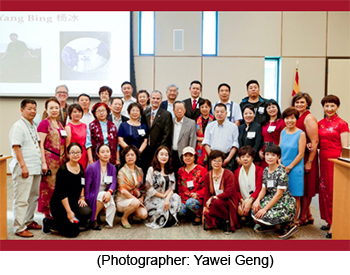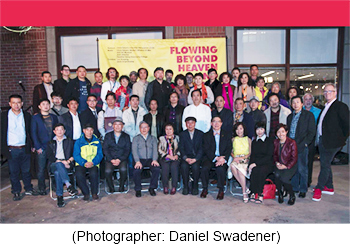Xiaohong Huang: Artist in Residence at PVCC, Spring 2017
Xiaohong Huang is the daughter of one of the most renowned ceramic artists, Huang Maijiu, who specializes in the famed “Blue and White” porcelain. Born in Jingdezhen in 1967, Xiaohong graduated from the Fine Arts Department of Jingdezhen Ceramic Institute in 1995. Xiaohong is a senior professor of arts and crafts, and a master artist and craftsman in Jiangxi Province. During the spring of 2017, Xiaohong was invited as the Artist in Residence at PVCC. She shared her expertise with PVCC students (and some other MCCCD colleges and ASU) via lectures, demonstrations, and hands-on teaching. For more information about her Art in Residence work and experiences, click here.
In the video on the right, you can follow Xiaohong’s footprints in her hometown Jingdezhen, the “Porcelain Capital of China,” a city in east China’s Jiangxi Province. You will visit Xiaohong’s own studio virtually to enjoy her creative process under her father’s guidance, her exquisite and beautiful “Blue and White” artworks, as well as some awards for her accomplishments.
The Art of Teapot Making: Junya Shao
Have you ever had a nice cup of tea? If so, there’s a high probability that you’ve had some type of Chinese tea. With China being the birthplace of tea, it’s only fitting that teapot making goes hand in hand.
Meet Junya Shao (born 1974 - present), an internationally renowned ceramic artist, nicknamed “Miss Teapot”. Ms. Shao has participated in over 30 important exhibitions in China, the United States and Canada. She has delivered over 60 lectures on Yixing pots and has conducted workshops at more than 40 universities in the U.S., Canada and China. She has received a variety of awards in the U.S., Canada and South Korea.
Her works have been collected in important museums, including the ASU Art Museum. Ms. Shao uses natural Zisha Clay (purple clay), traditional tools and slab techniques to hand make her teapots, and transforms a thin paddled slab into a perfectly symmetrical form. The roots of this ancient technique date back 1000 years to the Song Dynasty. Working from that foundation, her works are contemporary expressions of her own ideas about color and form, yet drawing from the Yixing aesthetic.
Junya Shao's Current Exhibit
For more information about the artist and her career, please click the following links (enjoy the images though the text is in Chinese):
Junya Shao: Yixing & Beyond(1)
Junya Shao: Yixing & Beyond(2)
Food for Thought:
- How did Junya make the teapots more functional while keeping its aesthetic style?
- Judging by the videos’, do you think it would be easy or difficult to make a teapot? Why?
- Do you have any teapots in your home? What have you learned about teapot making that makes your teapots more interesting?


 Since Professor Bradley made such strong connections with ceramics faculty at the various Chinese institutions, an opportunity to exhibit in the United States was offered and gratefully accepted. With intensive preparation by a team from PVCC, on September 18, 2015, a group of Chinese ceramic artists came for a one-day exhibition and celebration held in the KSC100. The artists accompanied their works and enjoyed meeting faculty, staff, students and community members.
Since Professor Bradley made such strong connections with ceramics faculty at the various Chinese institutions, an opportunity to exhibit in the United States was offered and gratefully accepted. With intensive preparation by a team from PVCC, on September 18, 2015, a group of Chinese ceramic artists came for a one-day exhibition and celebration held in the KSC100. The artists accompanied their works and enjoyed meeting faculty, staff, students and community members. On the heels of this successful collaboration with PVCC, Xiaoping Luo and David Bradley quickly decided their alliance opened the door for additional Chinese artists to visit the U.S. This larger exhibition would include a tour of sights culminating in an exhibit at a well-known museum venue. This collaboration grew with the addition of Garth Johnson, curator of the ASU Ceramic Research Center in Tempe, and together dates were set and a catalog created for the Flowing Beyond Heaven and Earth Exhibit schedule for the spring of 2017.
On the heels of this successful collaboration with PVCC, Xiaoping Luo and David Bradley quickly decided their alliance opened the door for additional Chinese artists to visit the U.S. This larger exhibition would include a tour of sights culminating in an exhibit at a well-known museum venue. This collaboration grew with the addition of Garth Johnson, curator of the ASU Ceramic Research Center in Tempe, and together dates were set and a catalog created for the Flowing Beyond Heaven and Earth Exhibit schedule for the spring of 2017.